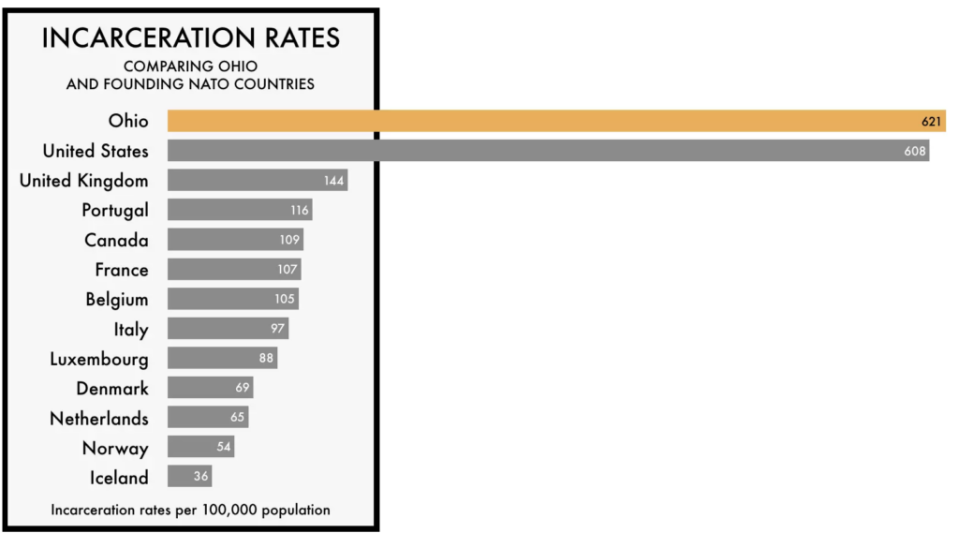As capital budget passes with more jail funding, Ohio incarceration ranks above most U.S. states

- Oops!Something went wrong.Please try again later.
(File photo by Caspar Benson/Getty Images)
A new report comparing incarceration rates in the U.S. and globally showed Ohio above many states and some countries, including the United States itself.
The Prison Policy Initiative released a report looking at the populations of state prisons, local jails, federal detention centers and other “systems of confinement” in the U.S. – which they found has the “highest incarceration rate of any independent democracy on earth” – and put those numbers in global context.
Ohio, the study showed, “out-incarcerates most other U.S. states,” at a rate of 621 residents per 100,000, according to Wanda Bertram, spokesperson for the Prison Policy Initiative.
Researchers used federal Bureau of Justice Statistics data, which showed a total of 45,313 people in Ohio’s state prisons, 20,582 in local jails and 4,728 in federal facilities.
Ohio’s number comes in above the U.S. rate of 608 per 100,000, and above 27 other states, according to the most recent data sets available. In a comparison that included countries selected because they have a population of at least 500,000, Ohio’s rate came in just below Rwanda, which was reported to have 637 incarcerated individuals per 100,000, according to the study.
El Salvador had the highest number reported in the study, with 1,086 incarcerations per 100,000 people.
The top U.S. state in the study was Louisiana, with 1,067 per 100,000, followed by Mississippi (1,020), Arkansas (912), Oklahoma (905), Alabama (898), Kentucky (889), Georgia (881), Tennessee (817) and South Dakota (812).
The lowest rate among U.S. states was Massachusetts, at 241 per 100,000 residents.
“While many in the U.S. have come to accept the nation’s high incarceration rate as a fact of life, by looking at these numbers through a global lens, we instead see it as an outlier, driven by failure to truly respond to issues such as homelessness, poverty, mental health needs and addiction,” Bertram said in a statement announcing the findings.
The findings were released just before Ohio passed its most recent capital budget – a separate budget from the state’s operating budget – which funds “capital assets of state agencies, colleges, universities and school districts,” according to the state’s Office of Budget and Management. Some capital budgets, including this year’s also include funding for specific community projects.
The budget signed by the Gov. Mike DeWine on June 28 finalizes funding plans for those assets in fiscal years 2025 and 2026.
“This capital budget is all about creating jobs, growing our economy and directly impacting the people of Ohio where they live and work,” DeWine said in a statement when he signed the bill.
In the capital budget, $255.1 million went to the Ohio Department of Rehabilitation and Correction “to make necessary infrastructure repairs in Ohio’s state prisons,” according to a release by DeWine’s office.
“This funding will also be used for facility upgrades to specifically support the aging inmate population and those with mental health disorders,” the release from DeWine’s office stated.
In addition to the infrastructure monies for state prisons, $50 million was set aside for local jails, along with $8.9 million for community-based correctional facilities.
In the state’s previous capital budget, the legislature included the same amount ($50 million) for local jail infrastructure, but pushed $303.2 million toward “general building renovations” at the ODRC. That budget included $6.3 million for community-based correctional facilities.
PPI has previously urged Ohio to focus on reforms to its criminal justice and prison systems, which included support for last year’s Issue 2, to legalize recreational marijuana in the state, and elimination of driver’s license suspensions and prohibitive license reinstatement and probation fees.
The state is still awaiting legislative tweaks to recreational marijuana law, despite the fact that marijuana has been legal in the state since December 2023.
GET THE MORNING HEADLINES DELIVERED TO YOUR INBOX SUPPORT NEWS YOU TRUST.
The post As capital budget passes with more jail funding, Ohio incarceration ranks above most U.S. states appeared first on Ohio Capital Journal.


